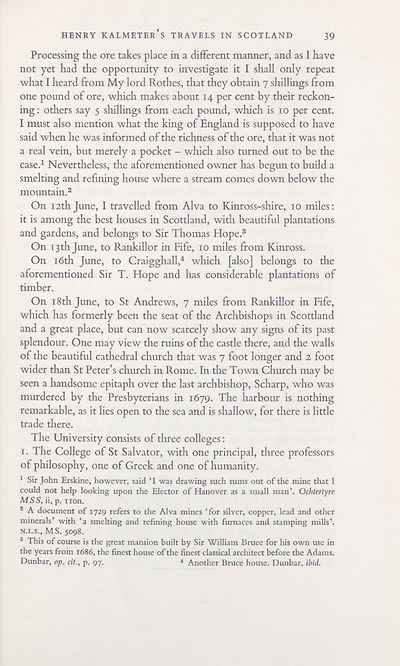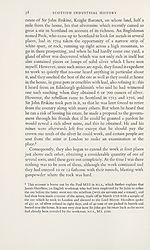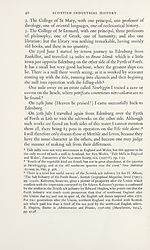Series 4 > Scottish industrial history
(84) Page 39
Download files
Complete book:
Individual page:
Thumbnail gallery: Grid view | List view

HENRY KALMETER’S TRAVELS IN SCOTLAND 39
Processing the ore takes place in a different manner, and as I have
not yet had the opportunity to investigate it I shall only repeat
what I heard from My lord Rothes, that they obtain 7 shillings from
one pound of ore, which makes about 14 per cent by their reckon¬
ing : others say 5 shillings from each pound, which is 10 per cent.
I must also mention what the king of England is supposed to have
said when he was informed of the richness of the ore, that it was not
a real vein, but merely a pocket - which also turned out to be the
case.1 Nevertheless, the aforementioned owner has begun to build a
smelting and refining house where a stream comes down below the
mountain.2
On 12th June, I travelled from Alva to Kinross-shire, 10 miles:
it is among the best houses in Scottland, with beautiful plantations
and gardens, and belongs to Sir Thomas Hope.3
On 13 th June, to Rankillor in Fife, 10 miles from Kinross.
On 16th June, to Craigghall,4 which [also] belongs to the
aforementioned Sir T. Hope and has considerable plantations of
timber.
On 18th June, to St Andrews, 7 miles from Rankillor in Fife,
which has formerly been the seat of the Archbishops in Scottland
and a great place, but can now scarcely show any signs of its past
splendour. One may view the ruins of the castle there, and the walls
of the beautiful cathedral church that was 7 foot longer and 2 foot
wider than St Peter’s church in Rome. In the Town Church may be
seen a handsome epitaph over the last archbishop, Scharp, who was
murdered by the Presbyterians in 1679. The harbour is nothing
remarkable, as it lies open to the sea and is shallow, for there is little
trade there.
The University consists of three colleges:
1. The College of St Salvator, with one principal, three professors
of philosophy, one of Greek and one of humanity.
1 Sir John Erskine, however, said ‘ I was drawing such sums out of the mine that I
could not help looking upon the Elector of Hanover as a small man’. Ochtertyre
MSS, ii, p. non.
2 A document of 1729 refers to the Alva mines ‘for silver, copper, lead and other
minerals’ with ‘a smelting and refining house with furnaces and stamping mills’.
N.L.S., MS. 5098.
3 This of course is the great mansion built by Sir William Bruce for his own use in
the years from 1686, the finest house of the finest classical architect before the Adams.
Dunbar, op. cit., p. 97. 4 Another Bruce house. Dunbar, ibid.
Processing the ore takes place in a different manner, and as I have
not yet had the opportunity to investigate it I shall only repeat
what I heard from My lord Rothes, that they obtain 7 shillings from
one pound of ore, which makes about 14 per cent by their reckon¬
ing : others say 5 shillings from each pound, which is 10 per cent.
I must also mention what the king of England is supposed to have
said when he was informed of the richness of the ore, that it was not
a real vein, but merely a pocket - which also turned out to be the
case.1 Nevertheless, the aforementioned owner has begun to build a
smelting and refining house where a stream comes down below the
mountain.2
On 12th June, I travelled from Alva to Kinross-shire, 10 miles:
it is among the best houses in Scottland, with beautiful plantations
and gardens, and belongs to Sir Thomas Hope.3
On 13 th June, to Rankillor in Fife, 10 miles from Kinross.
On 16th June, to Craigghall,4 which [also] belongs to the
aforementioned Sir T. Hope and has considerable plantations of
timber.
On 18th June, to St Andrews, 7 miles from Rankillor in Fife,
which has formerly been the seat of the Archbishops in Scottland
and a great place, but can now scarcely show any signs of its past
splendour. One may view the ruins of the castle there, and the walls
of the beautiful cathedral church that was 7 foot longer and 2 foot
wider than St Peter’s church in Rome. In the Town Church may be
seen a handsome epitaph over the last archbishop, Scharp, who was
murdered by the Presbyterians in 1679. The harbour is nothing
remarkable, as it lies open to the sea and is shallow, for there is little
trade there.
The University consists of three colleges:
1. The College of St Salvator, with one principal, three professors
of philosophy, one of Greek and one of humanity.
1 Sir John Erskine, however, said ‘ I was drawing such sums out of the mine that I
could not help looking upon the Elector of Hanover as a small man’. Ochtertyre
MSS, ii, p. non.
2 A document of 1729 refers to the Alva mines ‘for silver, copper, lead and other
minerals’ with ‘a smelting and refining house with furnaces and stamping mills’.
N.L.S., MS. 5098.
3 This of course is the great mansion built by Sir William Bruce for his own use in
the years from 1686, the finest house of the finest classical architect before the Adams.
Dunbar, op. cit., p. 97. 4 Another Bruce house. Dunbar, ibid.
Set display mode to:
![]() Universal Viewer |
Universal Viewer | ![]() Mirador |
Large image | Transcription
Mirador |
Large image | Transcription
Images and transcriptions on this page, including medium image downloads, may be used under the Creative Commons Attribution 4.0 International Licence unless otherwise stated. ![]()
| Scottish History Society volumes > Series 4 > Scottish industrial history > (84) Page 39 |
|---|
| Permanent URL | https://digital.nls.uk/126656019 |
|---|
| Description | Over 180 volumes, published by the Scottish History Society, containing original sources on Scotland's history and people. With a wide range of subjects, the books collectively cover all periods from the 12th to 20th centuries, and reflect changing trends in Scottish history. Sources are accompanied by scholarly interpretation, references and bibliographies. Volumes are usually published annually, and more digitised volumes will be added as they become available. |
|---|


